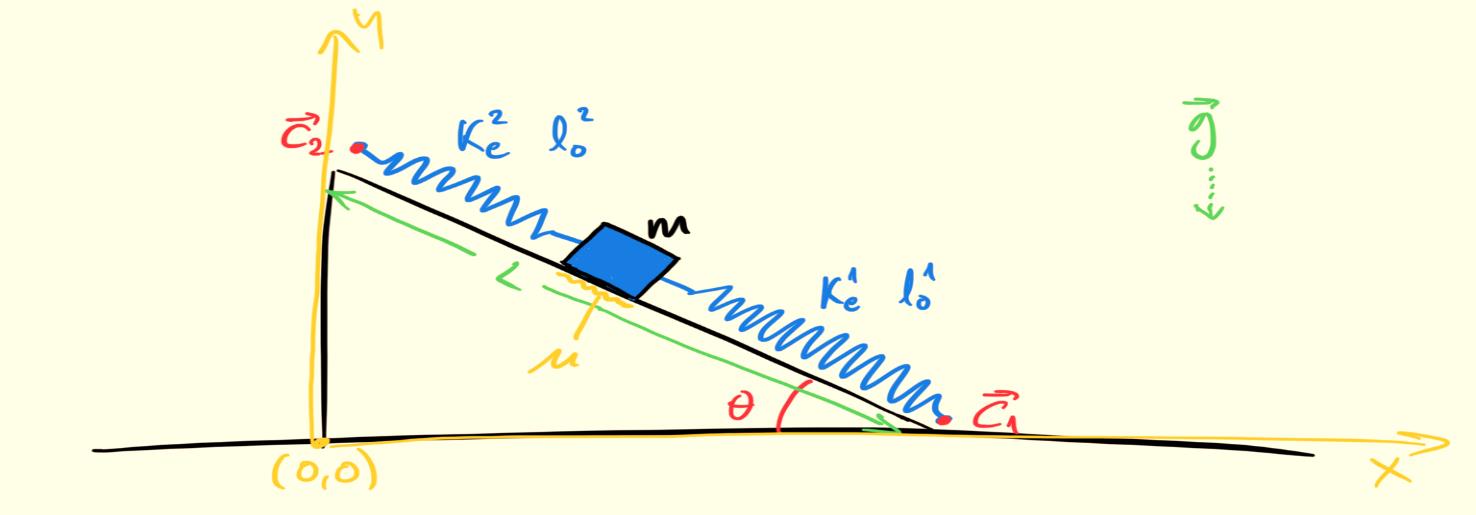Simulation subject within the Multimedia Engineering degree from the ETSE - Universitat de València. March 2022. Practice 1, exercise 1. Rating 8.5. An inclined plane had to be simulated with a mass, also inclined, subject to the force of two springs, using numerical integration methods.
🎞️ Video with the result: https://www.youtube.com/watch?v=xEUnrd95nZI
Considering a particle of mass 𝑚, located on an inclined plane, whose inclination is 𝜃 degrees, and whose length is 𝐿. The particle is held at both ends of the inclined plane by two springs. Each of the two springs has a different spring constant and resting elongation.
In a spring, when its elongation is less than the rest elongation, the spring expands due to the action of elastic force; When it is greater, the spring is compressed. The particle will initially be located at the midpoint of the inclined plane, and due to the elastic forces and the force of weight caused by gravity, it will begin to accelerate with acceleration 𝑎 and move with speed 𝑣, modifying its position 𝑠. There will also be a normal force, which will counteract the effect of the force of the weight in a direction perpendicular to the plane and will prevent the particle from passing through it.
In addition, the particle will be slowed down by friction with the air, which will cause it to lose energy. We will assume that the magnitude of the friction force will be proportional to the square of the speed, with a proportionality factor. There will also be friction between the particle and the plane, the magnitude of which will be linearly proportional to the normal force, with a proportionality factor.
Considerando una partícula de masa 𝑚, ubicada en un plano inclinado, cuya inclinación es 𝜃 grados, y cuya longitud es 𝐿. La partícula se mantiene en ambos extremos del plano inclinado mediante dos resortes. Cada uno de los dos resortes tiene una constante de resorte y un alargamiento en reposo diferentes.
En un resorte, cuando su alargamiento es menor que el alargamiento en reposo, el resorte se expande debido a la acción de la fuerza elástica; Cuando es mayor, el resorte se comprime. La partícula se ubicará inicialmente en el punto medio del plano inclinado, y debido a las fuerzas elásticas y a la fuerza del peso provocada por la gravedad comenzará a acelerar con aceleración 𝑎 y a moverse con velocidad 𝑣, modificando su posición 𝑠. También habrá una fuerza normal, que contrarrestará el efecto de la fuerza del peso en dirección perpendicular al plano y evitará que la partícula lo atraviese.
Además, la partícula se verá frenada por la fricción con el aire, lo que hará que pierda energía. Supondremos que la magnitud de la fuerza de fricción será proporcional al cuadrado de la velocidad, con un factor de proporcionalidad. También habrá fricción entre la partícula y el plano, cuya magnitud será linealmente proporcional a la fuerza normal, con un factor de proporcionalidad.
